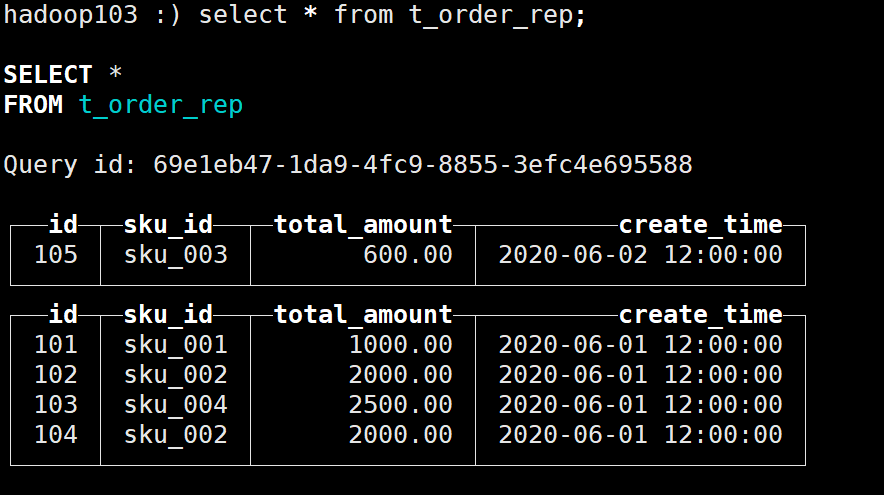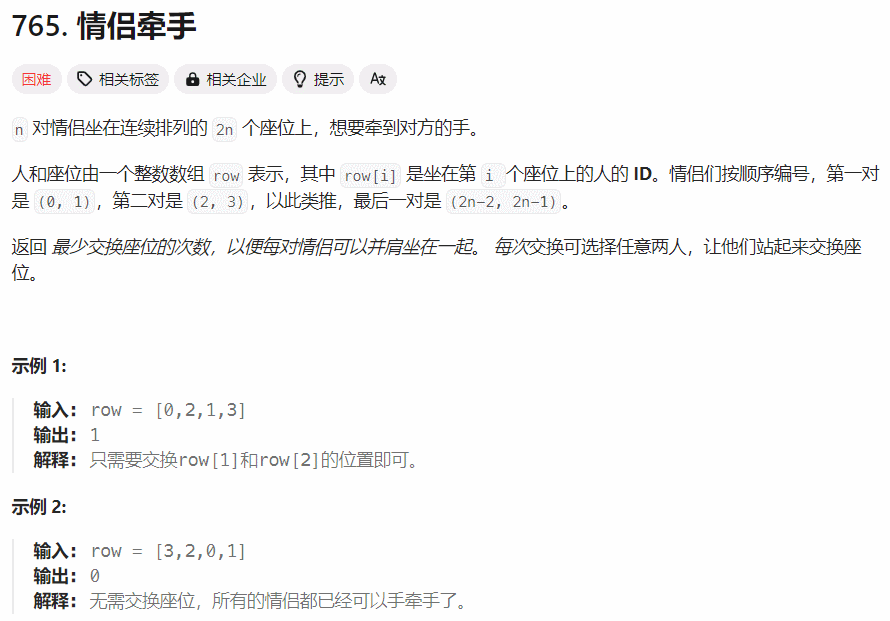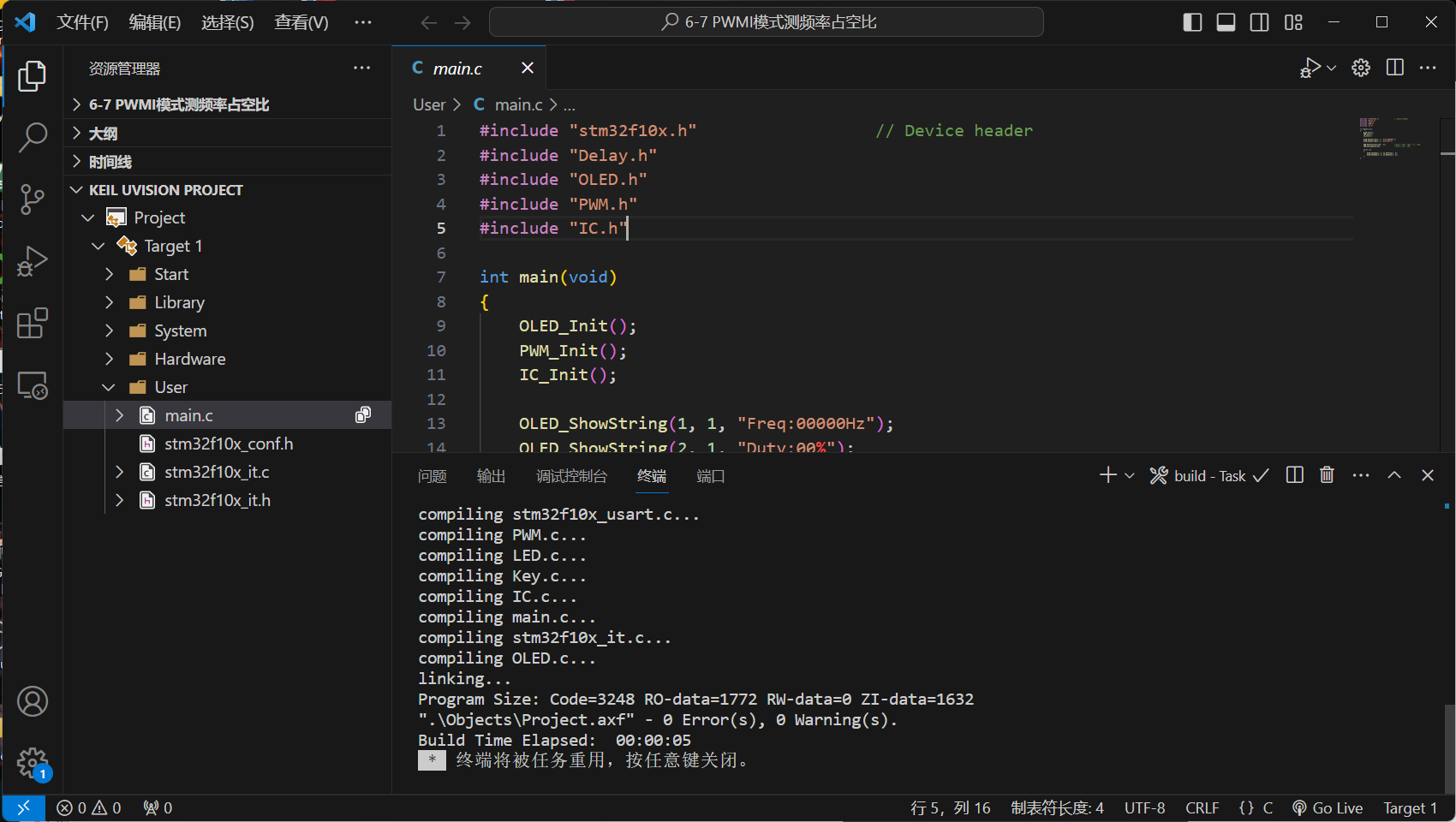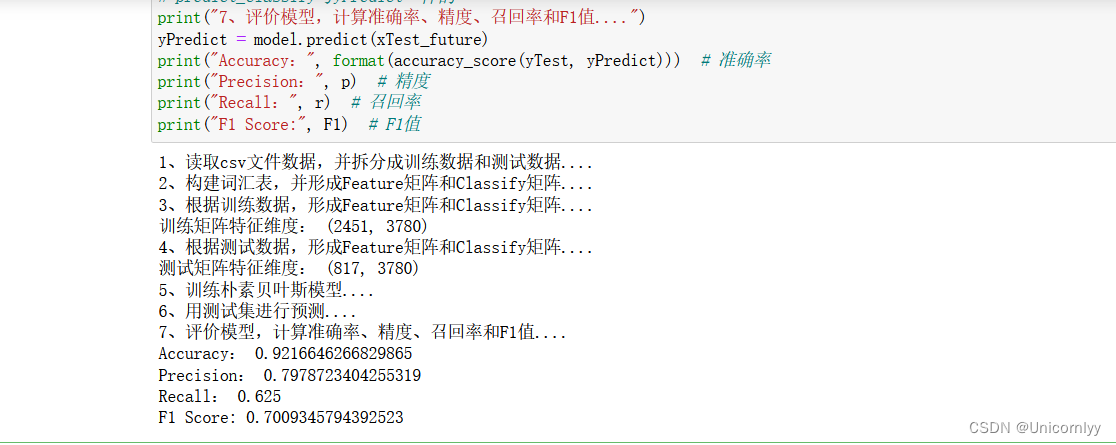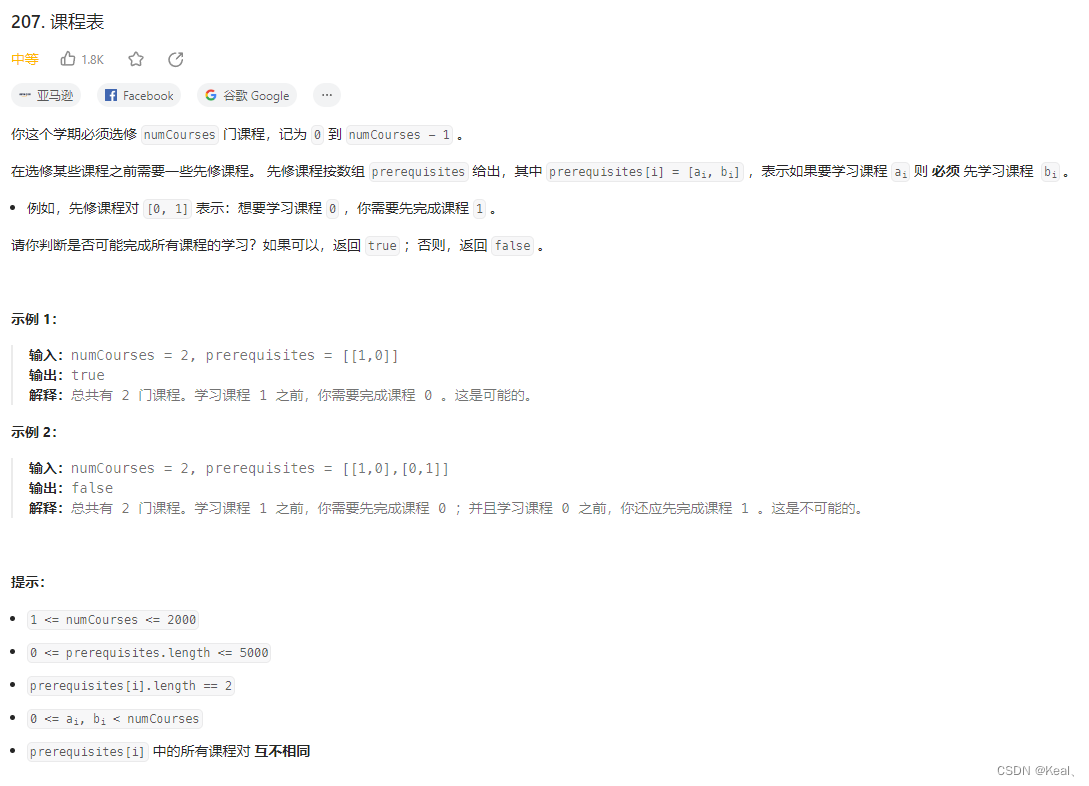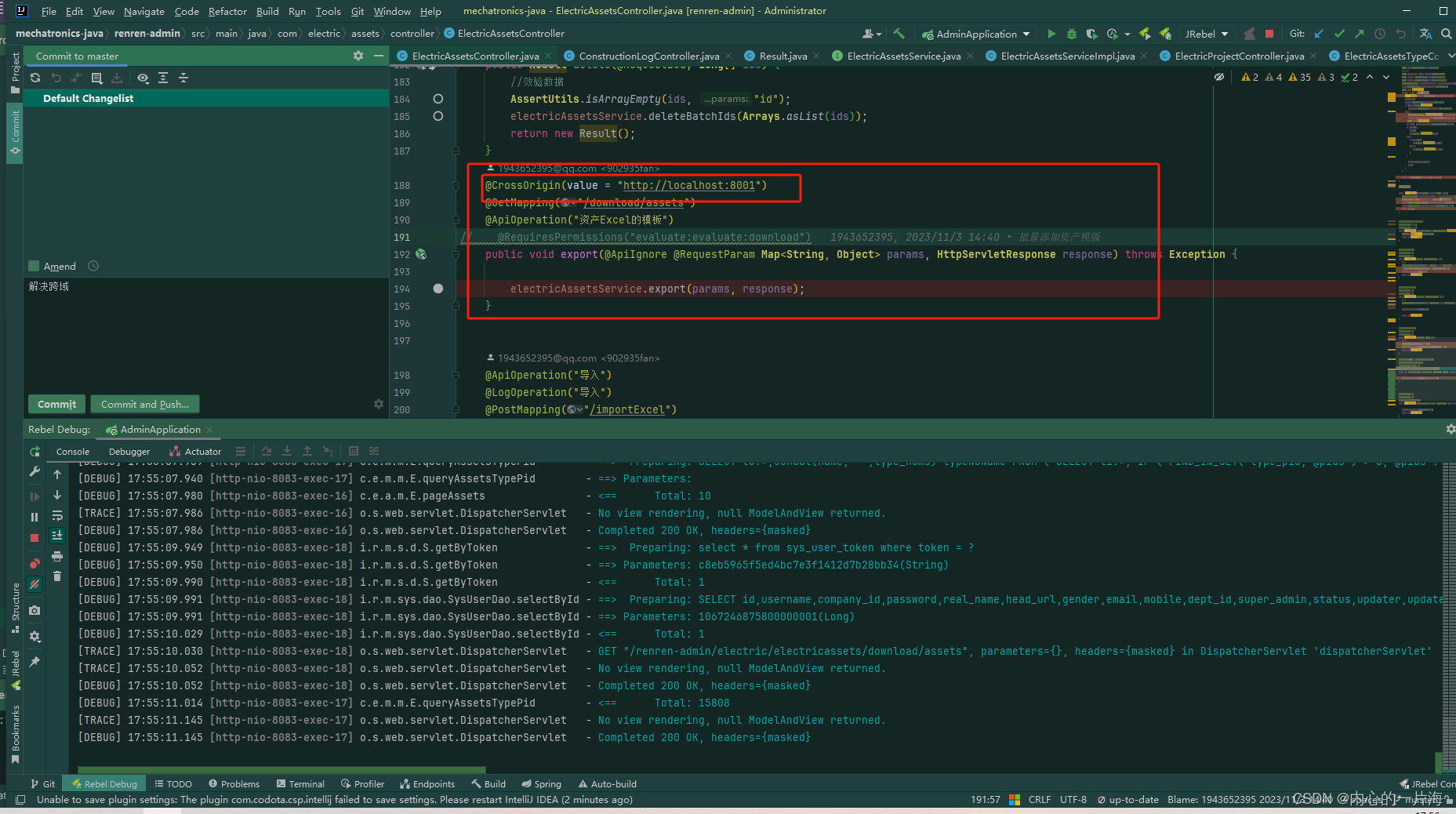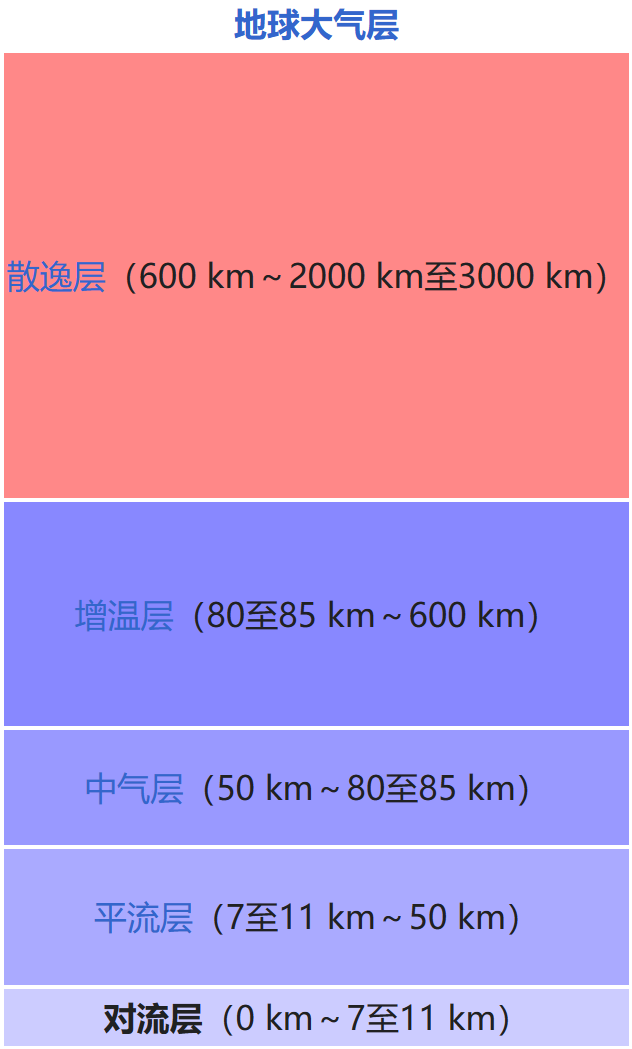目录
1.移除链表元素√
2.反转链表
3.相交链表
4.链表的中间节点
5.链表中倒数第k个节点
6.合并链表√
7.分割链表√
今天链表面试OJ题目
- 移除链表元素
- 反转链表
- 相交链表
- 链表的中间节点
- 链表中倒数第k个节点
- 合并链表
- 分割链表
-
🙂起始条件 中间节点 结束条件 - 🙂结束条件while易错
- 🙂单独处理头和尾
- 🙂处理链表为NULL的情况
- 🙂释放的先后顺序-----野指针
- 🙂指针的指向问题tail / tail->next
- && || == = (赋值)
- return 返回值的问题
- 🙂往极端情况考虑
1.移除链表元素√
给你一个链表的头节点
head和一个整数val,请你删除链表中所有满足Node.val == val的节点,并返回 新的头节点 。

输入:head = [1,2,6,3,4,5,6], val = 6 输出:[1,2,3,4,5]
【双指针】
struct ListNode* removeElements(struct ListNode* head, int val)
{
struct ListNode*cur=head;
struct ListNode*prve=NULL;
while(cur)
{
if(cur->val == val)
{
if(prve)
{
prve->next=prve->next->next;
free(cur);
cur=prve->next;
}
else
{
head=head->next;
free(cur);
cur=head;
}
}
else
{
prve=cur;
cur=cur->next;
}
}
return head;
}
cur是指当前节点的指针
prve是指向前一个节点的指针
【三指针不带头节点】
struct ListNode* removeElements(struct ListNode* head, int val)
{
struct ListNode* cur=head;
struct ListNode* tail=NULL;
struct ListNode* newhead=NULL;
while(cur)
{
if(cur->val != val)
{
if(tail)
{
tail->next=cur;//易错
tail=tail->next;
}
//处理头
else
{
newhead=tail=cur;//易错
}
cur=cur->next;
}
else
{
struct ListNode* tmp=cur->next;
free(cur);
cur=tmp;
}
}
//处理尾
if(tail)
{
tail->next=NULL;
}
return newhead;
}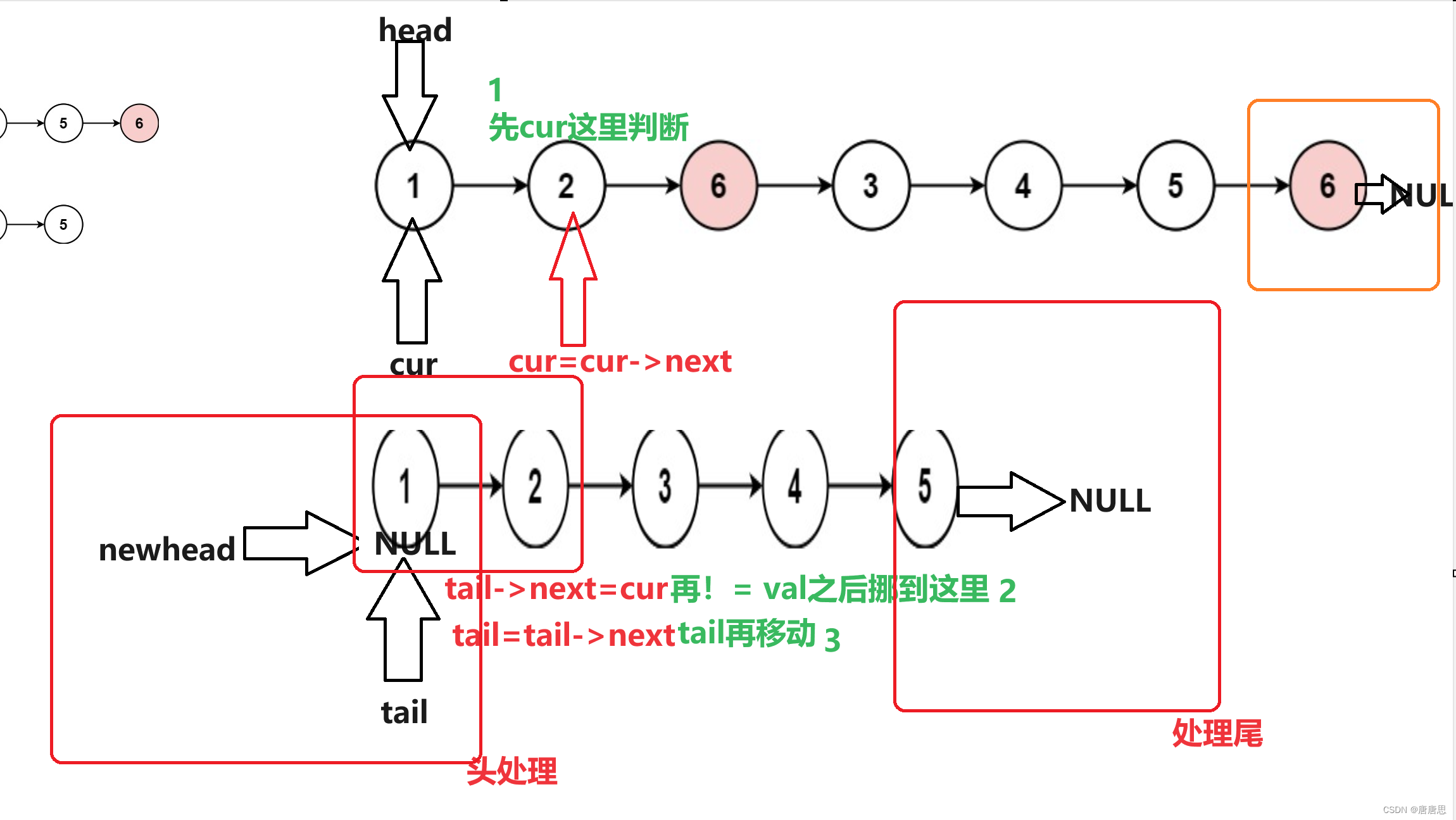
【三指针带头节点】
struct ListNode* removeElements(struct ListNode* head, int val)
{
struct ListNode* cur=head;
struct ListNode* newhead=(struct ListNode*)malloc(sizeof(struct ListNode));
struct ListNode* tail=newhead;
while(cur)
{
if(cur->val != val)
{
tail->next=cur;
tail=tail->next;
cur=cur->next;
}
else
{
struct ListNode* tmp=cur->next;
free(cur);
cur=tmp;
}
}
//处理尾
if(tail)
{
tail->next=NULL;
}
struct ListNode*tmp=newhead;
newhead=newhead->next;
free(tmp);
tmp=NULL;
return newhead;
}2.反转链表
给你单链表的头节点
head,请你反转链表,并返回反转后的链表。

输入:head = [1,2,3,4,5] 输出:[5,4,3,2,1]
【头插】
struct ListNode* reverseList(struct ListNode* head)
{
struct ListNode*newhead=NULL;
struct ListNode*cur=head;
while(cur)
{
struct ListNode*tmp=cur->next;
cur->next=newhead;
newhead=cur;
cur=tmp;
}
return newhead;
}
//可以不用处理头
struct ListNode* reverseList(struct ListNode* head)
{
struct ListNode*newhead=NULL;
struct ListNode*cur=head;
while(cur)
{
struct ListNode*tmp=cur->next;
if(newhead == NULL)
{
newhead = cur;
newhead->next = NULL;//易错
}
else
{
cur->next=newhead;
newhead=cur;
}
cur=tmp;
}
return newhead;
}
【三指针】
struct ListNode* reverseList(struct ListNode* head)
{
if(head == NULL)
{
return NULL;
}
struct ListNode*n1=NULL;
struct ListNode*n2=head;
struct ListNode*n3=head->next;
while(n2)//易错
{
n2->next=n1;
n1=n2;
n2=n3;
if(n3)
n3=n3->next;
}
return n1;//易错
}
3.相交链表
给你两个单链表的头节点
headA和headB,请你找出并返回两个单链表相交的起始节点。如果两个链表不存在相交节点,返回null。图示两个链表在节点
c1开始相交:
题目数据 保证 整个链式结构中不存在环。
注意,函数返回结果后,链表必须 保持其原始结构 。

输入:intersectVal = 8, listA = [4,1,8,4,5], listB = [5,6,1,8,4,5], skipA = 2, skipB = 3
输出:Intersected at '8'
解释:相交节点的值为 8 (注意,如果两个链表相交则不能为 0)。
从各自的表头开始算起,链表 A 为 [4,1,8,4,5],链表 B 为 [5,6,1,8,4,5]。
在 A 中,相交节点前有 2 个节点;在 B 中,相交节点前有 3 个节点。
— 请注意相交节点的值不为 1,因为在链表 A 和链表 B 之中值为 1 的节点 (A 中第二个节点和 B 中第三个节点) 是不同的节点。换句话说,它们在内存中指向两个不同的位置,而链表 A 和链表 B 中值为 8 的节点 (A 中第三个节点,B 中第四个节点) 在内存中指向相同的位置。
【双指针】
- 题目中有明确的说明两个链表都不为NULL
/**
* Definition for singly-linked list.
* struct ListNode {
* int val;
* struct ListNode *next;
* };
*/
struct ListNode *getIntersectionNode(struct ListNode *headA, struct ListNode *headB) {
int A=1;
int B=1;
struct ListNode *curA=headA;
struct ListNode *curB=headB;
int N=0;
while(curA->next)
{
A++;
curA=curA->next;
}
while(curB->next)
{
B++;
curB=curB->next;
}
if(curA != curB)
{
return NULL;
}
else
{
N=abs(A-B);
if(A>B)
{
while(N--)
{
headA=headA->next;
}
while(headA != headB)
{
headA=headA->next;
headB=headB->next;
}
return headA;
}
else
{
while(N--)
{
headB=headB->next;
}
while(headA != headB)
{
headA=headA->next;
headB=headB->next;
}
return headA;
}
}
}【简化】
/**
* Definition for singly-linked list.
* struct ListNode {
* int val;
* struct ListNode *next;
* };
*/
struct ListNode *getIntersectionNode(struct ListNode *headA, struct ListNode *headB) {
int A=1;
int B=1;
struct ListNode *curA=headA;
struct ListNode *curB=headB;
int N=0;
while(curA->next)
{
A++;
curA=curA->next;
}
while(curB->next)
{
B++;
curB=curB->next;
}
if(curA != curB)
{
return NULL;
}
else
{
N=abs(A-B);
//简写------假设法
struct ListNode *longlist=headA;
struct ListNode *shortlist=headB;
if(B>A)
{
longlist=headB;
shortlist=headA;
}
//
while(N--)
{
longlist=longlist->next;
}
while(longlist != shortlist)
{
longlist=longlist->next;
shortlist=shortlist->next;
}
return longlist;
}
} 
4.链表的中间节点
给你单链表的头结点
head,请你找出并返回链表的中间结点。如果有两个中间结点,则返回第二个中间结点。

输入:head = [1,2,3,4,5] 输出:[3,4,5] 解释:链表只有一个中间结点,值为 3 。
【快慢双指针】
- 保持相对速度
/**
* Definition for singly-linked list.
* struct ListNode {
* int val;
* struct ListNode *next;
* };
*/
struct ListNode* middleNode(struct ListNode* head)
{
struct ListNode*faster=head;
struct ListNode*slow=head;
while(faster && faster->next)//条件没想到
{
faster=faster->next->next;
slow=slow->next;
}
return slow;
}
5.链表中倒数第k个节点
输入一个链表,输出该链表中倒数第k个结点
示例1:输入:1,{1,2,3,4,5}
返回值:{5}
示例2:输入:6,{1,2,3,4,5}
返回值:{}
【快慢指针】
- 保持相对距离
-----------【k步】
struct ListNode* FindKthToTail(struct ListNode* pListHead, int k ) {
struct ListNode*faster=pListHead;
struct ListNode*slow=pListHead;
while(k--)//走k
{
if(faster == NULL)
{
return NULL;
}
faster=faster->next;
}
while(faster)
{
faster=faster->next;
slow=slow->next;
}
return slow;
}
----------------【k-1步】
/**
* struct ListNode {
* int val;
* struct ListNode *next;
* };
*/
/**
*
* @param pListHead ListNode类
* @param k int整型
* @return ListNode类
*/
struct ListNode* FindKthToTail(struct ListNode* pListHead, int k ) {
struct ListNode*faster=pListHead;
struct ListNode*slow=pListHead;
while(--k)//走k-1
{
if(faster == NULL)
{
return NULL;
}
faster=faster->next;
}
//当循环结束的时候faster为NULL
if(faster == NULL)//判断一下即可乖乖
return NULL;
while(faster->next)
{
faster=faster->next;
slow=slow->next;
}
return slow;
}

6.合并链表√
将两个升序链表合并为一个新的 升序 链表并返回。新链表是通过拼接给定的两个链表的所有节点组成的。

输入:l1 = [1,2,4], l2 = [1,3,4] 输出:[1,1,2,3,4,4
【三指针带头】
- 取小尾插
struct ListNode* mergeTwoLists(struct ListNode* list1, struct ListNode* list2) {
struct ListNode*cur1=list1;
struct ListNode*cur2=list2;
struct ListNode*newhead=NULL;
struct ListNode*tail=NULL;
if(list1 == NULL)
return list2;
if(list2 == NULL)
return list1;
while(cur1 && cur2)
{
if(cur1->val <= cur2->val)
{
if(newhead == NULL)
{
newhead=tail=cur1;//易错
}
else
{
tail->next=cur1;//已经放进去//易错
tail=tail->next;//tail是尾节点,可以往后移动了
}
cur1=cur1->next;
}
else
{
if(newhead == NULL)
{
newhead=tail=cur2;
}
else
{
tail->next=cur2;//已经放进去
tail=tail->next;//tail是尾节点,可以往后移动了
}
cur2=cur2->next;
}
}
if(cur1 == NULL)
{
tail->next=cur2;
}
else
{
tail->next=cur1;//已经不用在往后走了
}
return newhead;
}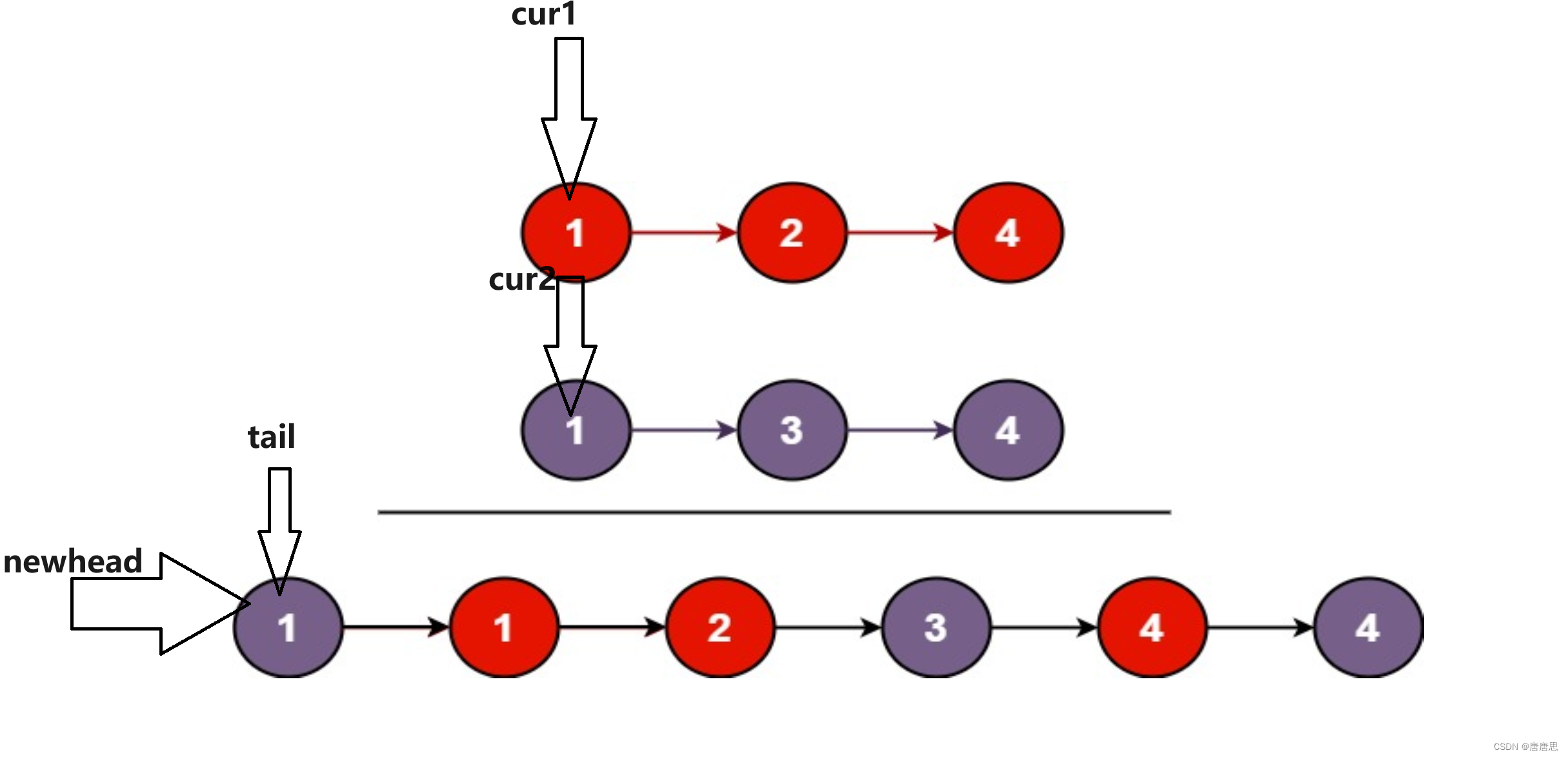
7.分割链表√
现有一链表的头指针 ListNode* pHead,给一定值x,编写一段代码将所有小于x的结点排在其余结点之前,且不能改变原来的数据顺序,返回重新排列后的链表的头指针。
【三指针带头】
/*
struct ListNode {
int val;
struct ListNode *next;
ListNode(int x) : val(x), next(NULL) {}
};*/
//用不带头节点来写,两个链表都可能为NULL,都要判断非常麻烦
//所以我们用带头节点来写
class Partition {
public:
ListNode* partition(ListNode* pHead, int x) {
ListNode* list1=(ListNode*)malloc(sizeof(ListNode));
ListNode* list2=(ListNode*)malloc(sizeof(ListNode));
ListNode* tail1=list1;
ListNode* tail2=list2;
ListNode* cur=pHead;
while(cur)
{
if(cur->val < x)
{
tail1->next=cur;
tail1=tail1->next;
}
else//cur->val >= x
{
tail2->next=cur;
tail2=tail2->next;
}
cur=cur->next;
}
//尾巴处理
tail1->next=list2->next;
tail2->next=NULL;//易错
return list1->next;
}
}; 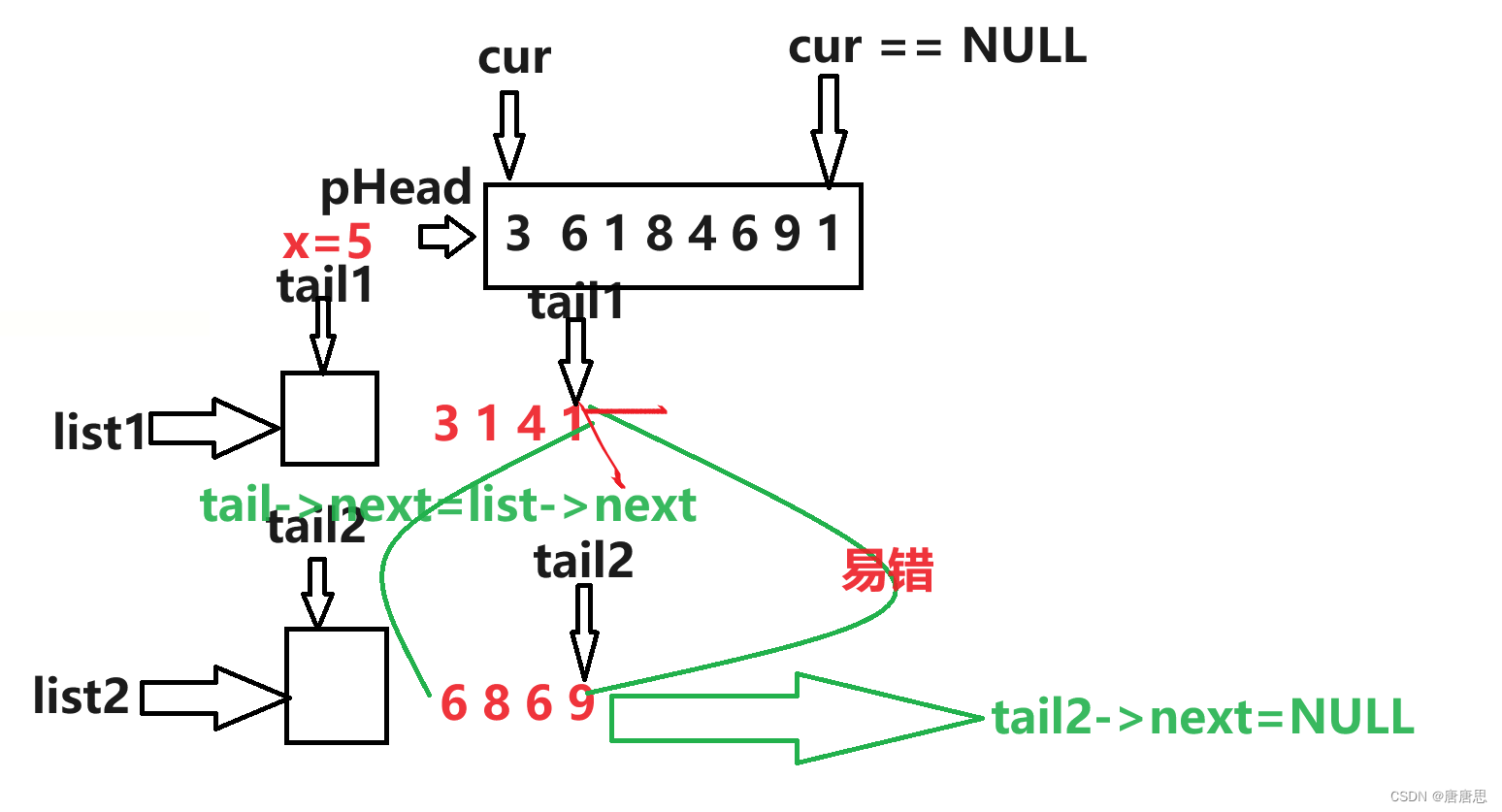
❓我们√三道题都有异曲同工之妙。
代码---------→【唐棣棣 (TSQXG) - Gitee.com】
联系---------→【邮箱:2784139418@qq.com】



